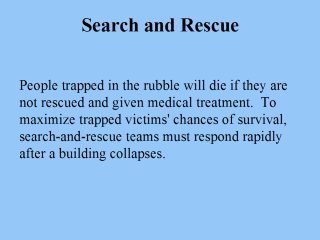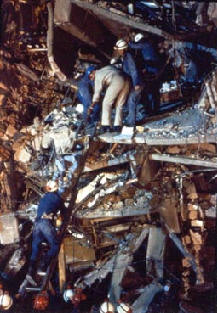
 |
Studies of the
1980 earthquake in Campania-Irpinia, Italy (111), the 1976 earthquake
in Tangshan, China (112), the 1988 earthquake in Armenia (33),
and the 1990 earthquake in the Philippines (66) show that the
proportion of trapped people found alive declined as the duration of
entrapment increased. In the Italian study, a survey of 3,619 survivors
showed 1) that 93% of those who were trapped and survived were extricated
within the first 24 hours and 2) that 95% of the deaths recorded occurred
while the victims were still trapped in rubble (111). Estimates of
the survivability of victims buried under collapsed earthen buildings in
Turkey and China indicate that within 2 to 6 hours less than 50% of those
buried are still alive (82). Although we cannot determine whether a
trapped person died immediately or survived for some time under the debris,
we can safely assume that more people would be saved if they were extricated
sooner. As suggested by these data, teams with specialized expertise in
areas such as search and rescue and on-site resuscitation and medical first
aid arriving more than a couple of days after an earthquake's impact are
unlikely to make much difference in the overall death toll of a large
earthquake (91). |
